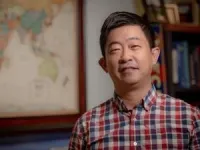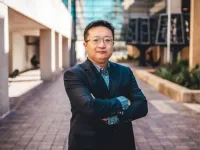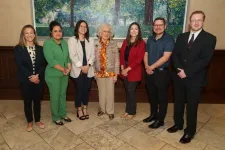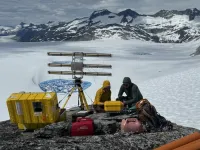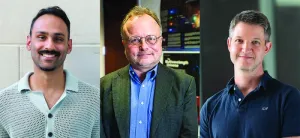(Press-News.org) One of the more promising classes of materials for next-generation batteries and electronic devices are the organic mixed ionic-electronic conductors, OMIECs for short. These soft, flexible polymer semiconductors have promising electrochemical qualities, but little is known about their molecular microstructure and how electrons move through them – an important knowledge gap that will need to be addressed to bring OMIECs to market.
To fill that void, materials scientists at Stanford recently employed a special electron microscopic technique that works with soft, so-called “beam-sensitive,” materials, such as biomolecules, to gain a clearer picture of the structural inner workings of OMIECs and why they enjoy such favorable electrochemical properties.
Like water in a car battery, a liquid electrolyte is infused between layers of OMIEC polymer. The electrolyte is the medium through which ions move between positive and negative poles creating electrical current.
“When OMIEC polymers are immersed in liquid electrolyte, they swell, like an accordion, yet maintain electronic functionality. We’ve learned that the long molecular chains of the polymer material are able to stretch and gently curve, creating a continuous path, even as the material swells by 300% with the electrolyte,” said Alberto Salleo, the Hong Seh and Vivian W. M. Lim Professor in the School of Engineering and senior author on the paper that appears in the journal Nature Materials.
“The research represents a conceptual breakthrough in visualizing the microstructure of these materials. Where previously we could only theorize, now we can see what is happening that makes the OMIECs work so well,” said Yael Tsarfati, a postdoctoral scholar in Salleo’s lab and first author of the paper who conducted most of the electron microscopy observations. “Learning how a material works at a structural level is key to designing ever-better materials.”
Elusive process
Salleo and Tsarfati have been working for three years on this study. They are the first to use cryo-electron microscopy (Cryo 4D-STEM) to image an OMIEC polymer soaked in an aqueous electrolyte while it hosts electrical charges. This type of microscope uses powerful beams of electrons – rather than light – to image and requires the sample to be extremely cold in order to prevent damage to the material from the electrons.
The dual stress of being soaked and charged electrically causes the polymer structure to change in complex but important ways, Salleo says. Visualizing how the performance of the polymer is maintained despite these stresses is a mystery that has intrigued the community. But it has been a challenge to image these polymers with traditional electron microscopes.
If OMIECs were solid semiconductors, researchers would quickly turn to electron microscopy to study their crystalline structure. But OMIECs are so soft that the powerful electron beams used to illuminate their inner structures damage them during observation.
Using this novel microscopy technique, Salleo and Tsarfati can now see how the soft, malleable polymer maintains its structural integrity as it expands. The team now believes that the soft liquid crystal polymer structure of OMIECs stretches and bends to form a continuous electronic path around bubbles of electrolyte that form between the folded ribbons of polymer.
Soft touch
Cryo 4D-STEM, in essence, freezes the material as it is being studied. The electrolyte does not turn solid, as water would turn to ice. Instead, it enters a different, vitrified state that allows Salleo and team to see into the microstructure in operation.
“The polymer forms a sort of gel that can bend and stretch,” Salleo explains. “It can swell a lot, sometimes 300 percent, which would completely destroy the electronic properties of most materials. But in OMIECs the electronic properties are still preserved.”
Tsarfati notes that once swollen, the polymer chains experience minimal structural change, even during charging and discharging. This leads to more efficient ion exchange with minimal strain on the material itself, making the OMIECs appealing from an electronic standpoint.
“The polymers exhibit impressive resilience to the physical changes and ion insertion compared to other materials we’ve studied and that’s a desirable trait for future electronics,” Tsarfati added, pointing to new directions for the team’s research.
Additional Stanford co-authors of this work include Colin Ophus, associate professor of materials science and engineering and center fellow at the Precourt Institute for Energy; Luke Balhorn, PhD ’22; Tyler Quill, PhD ’23; lab manager Adam Marks; and postdoctoral scholar Alexander Giovannitti. Additional authors are from Lawrence Berkeley National Laboratory; the University of California, Berkeley; the SLAC National Accelerator Laboratory; and the University of Oxford. Salleo is also a member of Stanford Bio-X and the Wu Tsai Neurosciences Institute, and an affiliate of the Precourt Institute for Energy.
This research was supported by funding from the U.S. Department of Energy, the National Science Foundation, the Toyota Research Institute, the Zuckerman-CHE STEM Leadership Program.
Part of this work was performed at the Stanford Synchrotron Radiation Lightsource at SLAC National Accelerator Laboratory, the Stanford Nano Shared Facilities, and the Donner Cryo-EM facility at LBNL.
END
Researchers illuminate inner workings of new-age soft semiconductors
2024-10-01
ELSE PRESS RELEASES FROM THIS DATE:
University of Houston partners with Harris County to create a sustainable energy future
2024-10-01
University of Houston researchers are partnering with the Harris County Office of County Administration’s Sustainability Office, the Harris County Energy Management Team and other county staff to develop a comprehensive baseline of energy use and energy-use intensity for county’s assets. Once established, the baseline will enable the team to track progress and evaluate the effectiveness of energy-saving measures over time, laying the groundwork for programs aimed at reducing energy consumption, maximizing savings, and increasing the use of renewable and resilient ...
Looking deeper into the mirror
2024-10-01
A team of Canadian and American scientists has made a promising breakthrough in understanding the origins of a mysterious neurological disorder known as mirror movements.
The discovery was made by Kaiyue Zhang, a doctoral student at the Montreal Clinical Research Institute (IRCM), affiliated with Université de Montréal, and by Karina Chaudhari, a doctoral student at the University of Pennsylvania.
As co-first authors, they published their study today in the journal Science Signaling.
They were led by Frédéric Charron, an UdeM research professor ...
Friends of BrainHealth donor circle awards coveted grants to fuel innovative research
2024-10-01
The 2024 Ramona Jones Friends of BrainHealth Luncheon on September 30, 2024 continued the 25th anniversary celebration of Center for BrainHealth – part of The University of Texas at Dallas – and the second year this annual event has been sponsored by founding Advisory Board member Ramona Jones and her family.
Staged “Shark Tank”-style” at the Dallas Country Club, the event featured a competition between emerging scientists pitching novel research proposals and vying for $20,000 in seed funding. Event co-chair Nikki Kapioltas opened the event, calling attention to a milestone ...
Study of infertility, health among women of Mexican heritage funded by $2.2M NIH grant
2024-10-01
Researchers at the University of Arizona Health Sciences and the Instituto Nacional de Salud Pública in Mexico are using a $2.2 million National Institutes of Health grant to explore the link between infertility and long-term health issues among Hispanic women of Mexican heritage.
According to recent research, female infertility is often associated with greater risks of cancer, cardiovascular disease and premature mortality. Hispanic women are up to 70% more likely to experience infertility than white women, yet little is known about their long-term health.
“Hispanics are the largest minority group in the United States, and 60% of Hispanics have Mexican heritage. ...
Airborne plastic chemical levels shock researchers
2024-10-01
A new study documents how Southern Californians are chronically being exposed to toxic airborne chemicals called plasticizers, including one that’s been banned from children’s items and beauty products.
Plasticizers are chemical compounds that make materials more flexible. They are used in a wide variety of products ranging from lunchboxes and shower curtains to garden hoses and upholstery.
“It’s not just for drinking straws and grocery bags,” said David Volz, environmental sciences professor at UC Riverside, ...
DOD awards $9M for snowpack and meltwater research and Arctic training program in Alaska and New England
2024-10-01
The Department of Defense (DOD) has awarded a $9 million contract to the University of Maine for research that will significantly expand efforts to quantify snowpack properties, explore the impact of snowmelt on the surrounding terrestrial environments of Alaska and Maine, and expand training opportunities in polar science.
The project is led by School of Earth and Climate Sciences and Climate Change Institute faculty member Seth Campbell, who will collaborate with more than a dozen other scientists from UMaine and other institutions. The effort builds on a related and existing ...
SETI Institute awards education grant through the STRIDE program
2024-10-01
SETI Institute Awards Education Grant through the STRIDE Program
October 1, 2024, Mountain View, CA – The SETI Institute awarded its first education grant through its Support Technology, Research, Innovation, Development and Education (STRIDE) program. The grant supports a new project called Encountering Stars in an Inflatable Planetarium, which will offer immersive astronomy and astrobiology experiences for elementary and middle school students in low-income areas and high school and adult audiences interested in STEM-related experiences. The program also includes a training workshop for K-12 teachers ...
NYU Historian Jennifer L. Morgan wins 2024 MacArthur “Genius Grant”
2024-10-01
New York University historian Jennifer L. Morgan, whose work focuses on the institutionalization of race-based slavery in early America and the Black Atlantic, has been named a 2024 MacArthur Fellow by the John D. and Catherine T. MacArthur Foundation.
MacArthur Fellows are recipients of the foundation’s “genius grants,” who each receive $800,000 over a five-year period to pursue intellectual, social, and artistic endeavors.
“The 2024 MacArthur Fellows pursue rigorous inquiry with aspiration and purpose,” says MacArthur Fellows Director ...
Research in 4 continents links outdoor air pollution to differences in children’s brains
2024-10-01
Outdoor air pollution from power plants, fires and cars continues to degrade human, animal and environmental health around the globe. New research shows that even pollution levels that are below government air-quality standards are associated with differences in children’s brains.
A University of California, Davis, research team systematically analyzed 40 empirical studies, the majority of which had found that outdoor air pollution is associated with differences in children’s brains. These differences include volumes of white matter, which is associated with ...
UTA physicists explore possibility of life beyond Earth
2024-10-01
Are there planets beyond Earth where humans can live? The answer is maybe, according to a new study from University of Texas at Arlington physicists examining F-type star systems.
Stars fall into seven lettered categories according to their surface temperature. They also differ in other factors including mass, luminosity, and radius. F-types are in the middle of the scale, hotter and more massive than our sun. F-type stars are yellowish white in color and have surface temperatures of more than 10,000 degrees.
A habitable zone (HZ) is the distance from a star at which water could exist on orbiting planets’ surfaces. In the research led by doctoral student Shaan Patel ...

